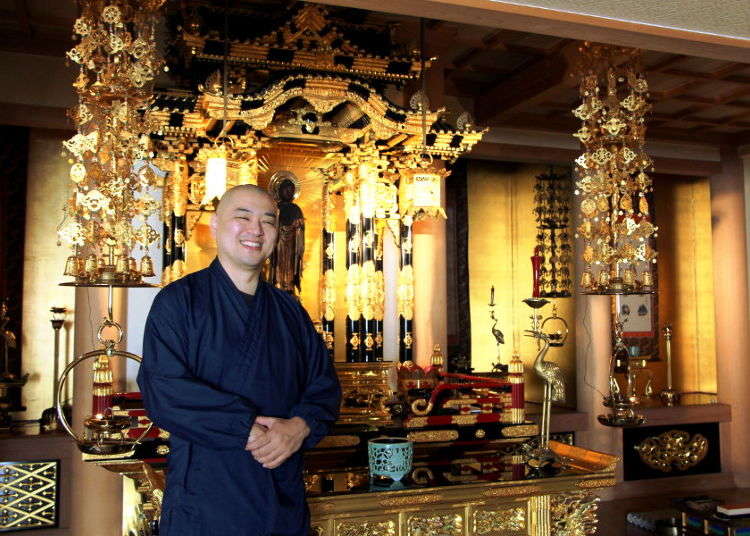
Of Tomatoes, Laptops, and Prejudice: Meeting the Monk of Kurayami Gohan, Tokyo’s Buddhist Dark Dinner
- Written by: Pamela Drobig
When I stood outside the tall, modern building in Asakusa that was supposed to be the Buddhist temple Ryokusen-ji, I did not know yet that I was about to meet one of the most amazing monks in Tokyo. Indeed, only the beautiful, bell-shaped window hinted at the building’s religious purpose. Was this really the place where Tokyo’s famous Kurayami Gohan, or dinner in the dark, was taking place regularly? As the name suggests, Kurayami Gohan is a dinner event that is held in light darkness and eye masks, with all the participants blindfolded and unable to see a thing. There are a lot of these kind of darkness restaurants all over the world, but Kurayami Gohan isn’t just a novelty thing – there’s a genuine Buddhist approach behind it all, but amore about that later.
Old Beliefs Meet Modern Technology

As I stared at the temple’s exterior in my morning haze, the broad sliding doors and a bald man in typically Japanese slippers and dark-blue clothes peeked out. As soon as he saw me, his face lit up with one of those particularly bright and infectious smiles that I couldn’t help but smile right back at him.
“Ah, good morning! Come in, come in”, he said, shoving both doors wide open to welcome me in. While the interior of Ryokusen-ji was just as modern as its exterior, it did sweep away every doubt about the building’s purpose: a wide, pleasantly smelling tatami room spread in front of me with a Buddhist altar in its center. A low table surrounded by four seating cushions stood in one of the rooms corners – an on it was a MacBook. The sight of the high-tech laptop in this traditionally Japanese and religious room made me smirk involuntarily. A Buddhist monk using a MacBook. Welcome to the 21st century!
Kakuho Aoe: Monk, Chef, People Person

And then I sat across from Kakuho Aoe, the chief monk of Ryokusen-ji and somewhat of a pop star among Tokyo’s Buddhists, the host of Kurayami Gohan, who immediately told me to please sit in a relaxed manner instead of a more formal seiza. In Aoe-san’s warm, welcoming presence, it was indeed very hard not to relax. Since he has studied and worked in the United States for years, I also wasn’t surprised that the conversation was taking place entirely in English – in fact, the Kurayami Gohan event is held in English twice a year.
When you eat, you just eat. Nothing else.
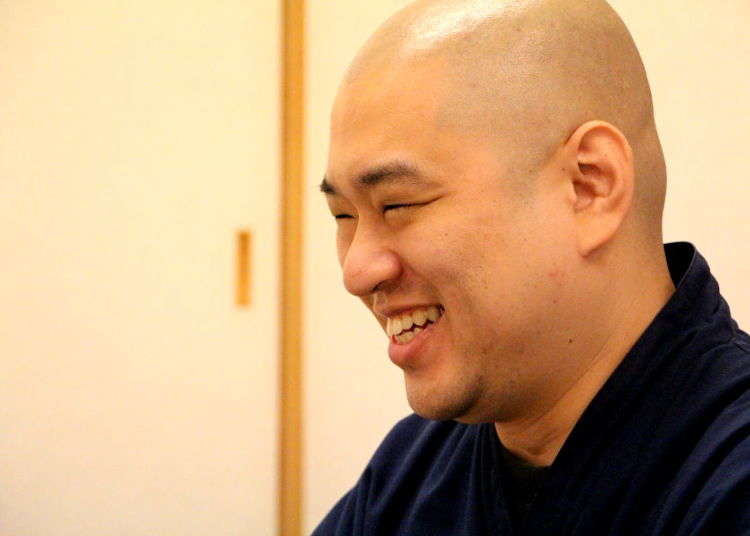
When I asked the obvious question – what lead him to start hosting Kurayami Gohan – Aoe-san nodded. “We’re living in a busy world, right? Where do you eat your breakfast?”, he immediately answered with a question, making clear from the very beginning that this interview would be a dynamic one. “In the office, before I start to work”, I admitted almost guiltily, already having an idea where this was going. “And what are you doing while eating?” Aoe-san wanted to know with a little knowing smile on his lips. Reading the newspaper of my phone, of course – like millions of other people not only in Japan.
“As a Buddhist monk, when you eat, you just eat. Nothing else”, Aoe-san explained and talked about how people in this day and age often think about work during breakfast or dinner. When you’re robbed of your eyesight, however, you suddenly have no other choice than focusing on your meal – simply because eating itself becomes the task to focus on and cannot be done on the side anymore. And just like that, there’s no room to think about something else anymore, not work, not relationships, nothing. “It’s a place to concentrate on eating”, says Aoe-san.
Discovering My Prejudices towards Tomato
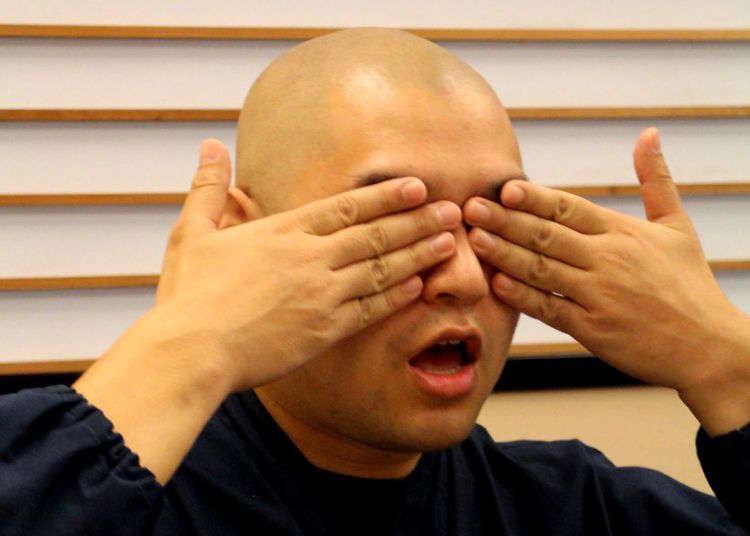
But there are other darkness restaurants in the world – what makes Kurayami Gohan so special, and where exactly does the Buddhism come into play? To answer this question, my cheerful interview partner opened his MacBook on which he had prepared a PowerPoint presentation. He pulled up an image of one of the dishes he serves – all of Kurayami Gohan’s dishes are made by him, by the way. It looked a bit like vanilla pudding with a half-transparent, orange sauce on the side. “What do you think this is?” he asked me, pointing at this very sauce.
I squinted my eyes and tilted my head. “Um... orange, maybe? I don’t really know”, I answered and shrugged. Of course, Aoe-san smiled brightly. “It’s tomato.” ...What? This semi-transparent sauce was supposed to be tomato? It lacked the vivid red and the usual thickness of a good tomato sauce. But I wasn’t alone in my misjudgment, apparently only sixty percent of the people got it right when asked about it. “But when they’re blind”, said Aoe-san and put his hands over his eyes. “Ninety-eight percent of people say it’s tomato.”
The Message of Food and the Finding of Answers
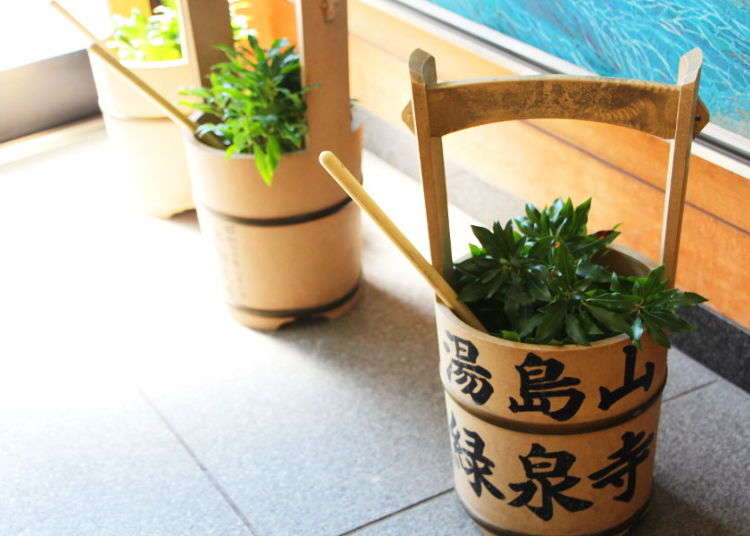
What does the tomato stand for, though? “People have prejudices and preconceptions”, explains the Buddhist monk. “And we cannot find the right answer when prejudiced.” I stared at him for a moment – there it was, a Buddhist truth that often seems to be so terribly abstract, suddenly painfully obvious thanks to a simple tomato dish.
He laughed warmly when he saw the amazement on my face and, after I asked him why he chose food to convey this message, continued: “Eating is something done regularly”, Aoe-san said. And, building a bridge to finding a small place of respite from the busy daily life, Aoe-san hopes that every guest of his will be able to take away a positive experience and remember it every time they eat. “Food has a message. I hope that people let go of stress and business.”
Finding a Friend in the Dark

Aoe-san doesn’t only offer a culinary experience and a mental place of peace, however. “The entrance should be fun”, he says about the Kurayami Gohan experience, as a lot of people are nervous about being in the dark. To take this fear away, he has his diners play a game of Rock-Paper-Scissors in the dark. And because no one can see a thing, people need to touch the hands of their seating partner to determine who won the match. “It’s like finding a friend in the darkness”, Aoe-san explains, smiling. “The world suddenly expands.”
The entrance is funny but the exit is supposed to be interesting – he wants people to take something away from the experience. To him, it doesn’t matter what it is, as everyone makes their own experiences in the dark. “Some people say the food tastes like nothing!” he laughs when I asked about the feedback he receives. “Others say that the tastes become more intense.”
Of Becoming a Monk and the Things we Can Do
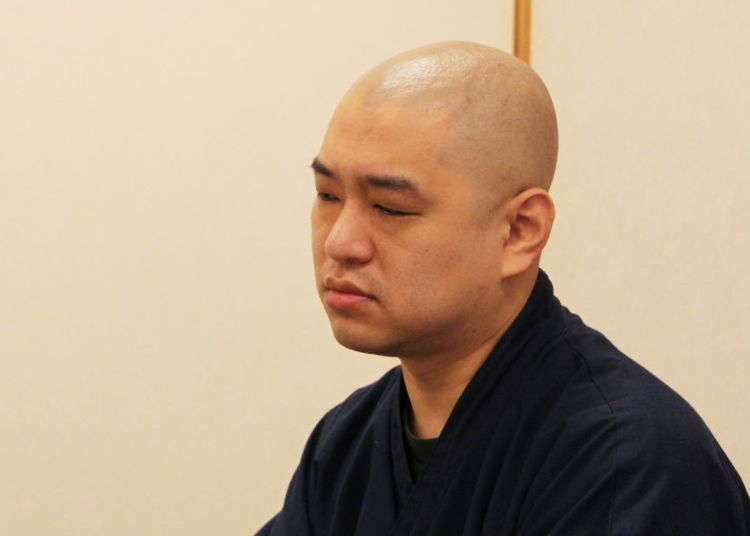
Laughing is something that Aoe-san does a lot, in this very infectious way that I described in the beginning. Listening to him talk isn’t only incredibly interesting but also relaxing, in a way – he is one of the youngest and most modern monks that I’ve ever met but that probably are the very reasons why it felt so easy to relate and talk to him.
After talking about Kurayami Gohan, Aoe-san wasn’t shy to share a personal story as well. When he was young, he didn’t think about taking over the temple and becoming a monk himself, which is why he went to the States.
But then 9.11 happened – and as this day changed the life of so many people, as did it change the life of Kakuho Aoe. “I realized that I couldn’t do anything”, he said, and just as he was openly cheerful, he was openly shaken when talking about his experiences with the attack. Following this day, he decided to return to Japan and try Buddhism – and eventually fell in love with it. When the Great Tohoku Earthquake and Tsunami happened on 3.11, triggering the Fukushima crisis, Aoe-san was there, to “cook and chant Buddhist sutras for the people in Tohoku.” And this time, he was able to do something.
Getting Ready for a Dinner in the Dark
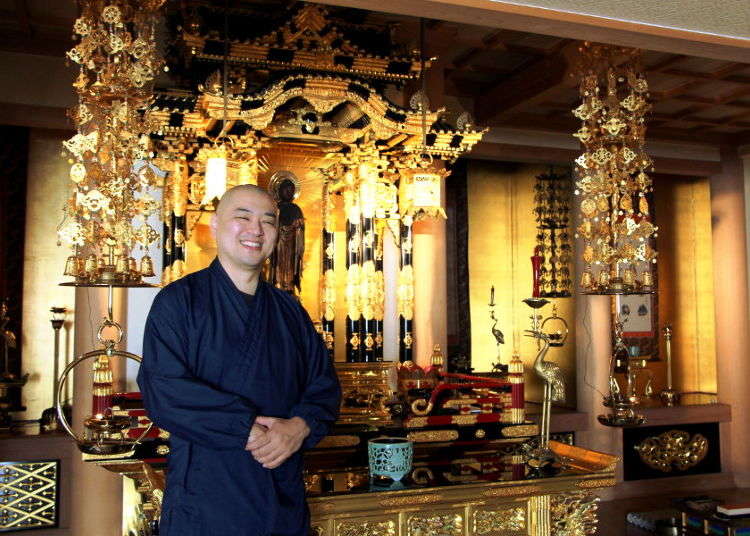
Just by talking to Aoe-san for an hour, I already felt like I learned great many things – or at least got a different perspective on some. First and foremost, my prejudices about Buddhist monks have been utterly thwarted by Aoe-san. Secondly, I am very much looking forward to making my own experiences at Kurayami Gohan, to which I will be going in a bit – so be sure to stay tuned! Lastly, I want to pass on what Aoe-san told me when I asked about what kind of advice he has for non-Japanese people wanting to try Kurayami Gohan for themselves:
“Enjoy!” (laughs)
-

-
Address
1-8-5, Nishiasakusa, Taitou-ku, Tokyo, 160-0021
View Map -
Nearest Station
Tawaramachi Station (Tokyo Metro Ginza Line)
2 minutes on foot
-
Address
1-8-5, Nishiasakusa, Taitou-ku, Tokyo, 160-0021
Having graduated in Japanese Studies in Berlin, she returned to Japan in 2014. She focuses on writing and translations from Japanese to English, contemporary culture and society, as well as history and lore of Japan.
- Area
- Category
*Prices and options mentioned are subject to change.
*Unless stated otherwise, all prices include tax.
Popular Tours & Activitiess
Recommended places for you
-

Tokyosumomatsuri
Japanese cuisine
Ginza
-
Menu

Ganso Kamameshi Haru
Japanese cuisine
Asakusa
-

Oto-Oto Ikebukuro
Japanese cuisine
Ikebukuro
-

Kurayamizaka Miyashita Marubiru
Japanese cuisine
Tokyo Station
-

Ginza Tosaryori Neboke
Japanese cuisine
Ginza
-

NIIGATASADONOSYUNTOJIZAKENODOGURONOAKUBIOKACHIMACHI
Japanese cuisine
Ueno
-

First Japan Cherry Blossom 2026 Forecast Announced! Here's When & Where to See Sakura in Japan
-
Ad

Complete Guide to Ueno's National Museum of Nature and Science, the Perfect Place to Visit on Rainy Days or With Children
-

Jujutsu Kaisen Takes Over JR East With a Wrapped Shinkansen This Winter
by: Guest Contributor
-
Ad

(Opening in Jan 2026) 'THE SUMO LIVE RESTAURANT HIRAKUZA GINZA TOKYO!' 5 Exciting Ways to Experience the World of Sumo!
-

Strawberries, Style, and Tokyo’s Coolest Neighborhood: Winter Afternoon Tea in Kichijoji
by: Guest Contributor
-

This Winter, Godzilla Takes Over Haneda Airport
by: Guest Contributor
Inspiration for Accommodations
-

Enjoy Mt. Fuji from the Comfort of Your Room! Recommended Ryokan with Mt. Fuji View
-

Stay Near the Cherry Blossoms! Hotels for Cherry Blossom Viewing in Tokyo
-

Family-Friendly Hotels with Free Shuttle to Disneyland: Convenient Access for a Magical Stay
-

Top Ranked Hakone Hotels with Mt. Fuji View: Enjoy Stunning Scenery from Your Private Space
-

Convenient Tokyo Hotels with Airport Shuttle: Ideal for Families and Heavy Luggage
-

Stunning Tokyo Tower View Hotels: Enjoy Spectacular Scenery from Your Private Space
-

Convenient Asakusa Hotels with Kitchens: Ideal for Extended Family Visits
-

Experience Luxury: Hakone's 10 Best Five-Star Accommodations
-

Enjoy Mt. Fuji Autumn Leaves! Top Hotels Near the Popular Autumn Leaves Corridor
-

Experience Hakone Fall Foliage from Your Room with Stunning Views
-

What to Pack for Japan: 8 Essential Things for a Hassle-Free Trip
-

Kichijoji – Explore Tokyo’s Top-Rated Stylish Suburb in Half a Day!
-

Tokyo Brunch: 4 of our Favorite Spots for a Japanese-style Brunch in Asakusa!
by: David McElhinney
-

(Video) Walking Tour along Narita Omotesando - Quaint Historical Village near Narita Airport!
by: Victor Gonzalez
-

Kita no Kuni Bar in Shinjuku – Feasting on Fresh Hokkaido Delicacies in the Heart of Tokyo!
-

Viva Vegan in Japan! 4 Mouth-Watering Vegan Restaurants to Visit in Tokyo
- #best ramen tokyo
- #what to buy in ameyoko
- #what to bring to japan
- #new years in tokyo
- #best izakaya shinjuku
- #things to do tokyo
- #japanese nail trends
- #what to do in odaiba
- #onsen tattoo friendly tokyo
- #daiso
- #best sushi ginza
- #japanese convenience store snacks
- #best yakiniku shibuya
- #japanese fashion culture
- #best japanese soft drinks













